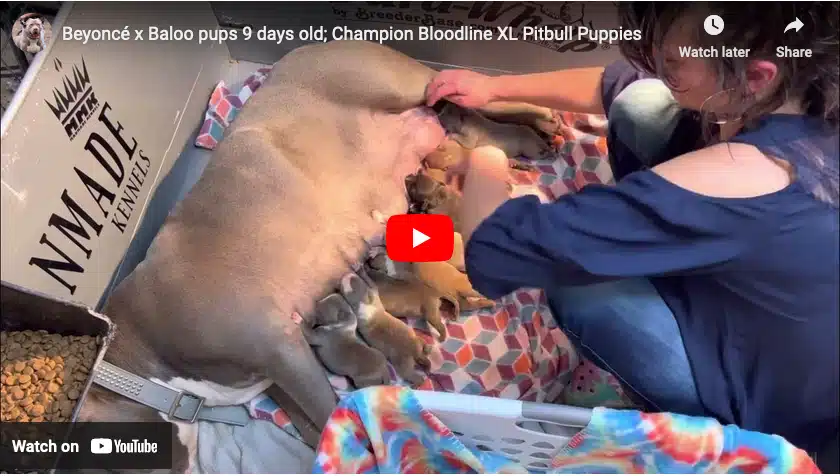Breeding puppies is an exciting journey, but it can also be a challenging and potentially risky endeavor. Especially for first-time dog breeders. There are several crucial factors to consider, from the preparation before breeding to the care of the puppies after they arrive.
In this article, we will explore the five deadliest puppy whelping mistakes that first-time dog breeders often make. By understanding these mistakes and taking the necessary precautions, you can increase the chances of a successful and healthy breeding experience.
Mistake #1: Mistaking a Puppy Born in the Sac as Stillborn
One of the deadliest puppy whelping mistakes we see breeders make is assuming that a puppy born in the sac is still-born. This is far from the truth, most of these puppies are alive and need a little tender loving care to bring them back to life.
Normally, the mother dog would immediately tend to the puppies once they are born. They will chew the amniotic sac away and lick the amniotic fluid off the puppy’s nose to help the pup draw its first breath. Sometimes, a little extra licking and moving the puppy around is the best motivation to nudge the puppy to life.
However, sometimes the mother dog is too tired to do the extra work. Dogs that deliver through elective c-section may experience an inadequacy of the love hormone oxytocin. This hormone is responsible for helping nursing dogs bond with their newborn puppies. More on this later.
When the mother dog neglects the puppies, some of them may remain in the sac when born. They are not dead but need a little tender loving care to help them breath. First, remove the puppy from the sac and shake the puppy a few times to wake it up. This is perfectly normal as nurses do the same when delivering babies that fail to cry when they are born.
If the puppy is still silent, it’s possible it is not breathing properly due to fluids still lodged in the puppy’s nostrils. You can help the puppy breathe by sucking out amniotic fluids from the nose using a syringe.
Mistake #2: Inadequate temperature control in whelping box
Maintaining an appropriate temperature in a whelping pen is crucial for the well-being of newborn puppies. The ideal temperature helps keep the puppies comfortable and supports their early development. Here are general guidelines for the ideal temperature in a whelping pen:
- Newborn Puppies (0-7 Days):
- For the first week of life, newborn puppies are unable to regulate their body temperature effectively. Keep the whelping box temperature between 85°F to 90°F (29°C to 32°C). This higher temperature mimics the warmth they would experience with their mother.
- One to Three Weeks Old:
- As the puppies grow, you can gradually decrease the temperature in the whelping pen. Aim for a range of 80°F to 85°F (27°C to 29°C) during the second and third weeks.
- Three to Four Weeks Old:
- By the fourth week, puppies start developing the ability to regulate their body temperature more effectively. You can further reduce the temperature to around 75°F to 80°F (24°C to 27°C).
- Four Weeks and Older:
- Beyond four weeks, puppies should be acclimated to room temperature. Maintain a comfortable room temperature, typically around 70°F to 75°F (21°C to 24°C).
Mistake #3: Not hydrating newborn puppies
A third and common puppy whelping mistakes is not hydrating the newborn puppies. Ensuring proper hydration in a newborn puppy is crucial, especially if they miss a feeding and are at risk of dehydration. While it’s essential to follow regular feeding schedules and monitor the mother dog’s milk production, there are situations where intervention becomes necessary.
When dehydration in newborn puppy is severe and life-threatening, subcutaneous fluids can be administered. Use a syringe to inject 1 to 2 CCs of lukewarm water under the skin. Make sure the needle does not touch the body. Lift the skin away from the body, insert the needle at a shallow angle, and inject the fluids slowly. This method helps hydrate the puppy by allowing the body to absorb the fluids over time.
Newborn puppy hydration tips to remember
- Use lukewarm not cold water-When preparing fluids for hydration, ensure they are lukewarm and not cold. Cold fluids may cause discomfort and stress to the puppy, making it less likely for them to consume it willingly.
- Establish a regular Feeding Schedule– Stick to a consistent feeding schedule for the newborn puppies, ideally every 2-4 hours. Missing a feeding can lead to dehydration, so it’s crucial to be attentive to their needs.
- Monitor Mother Dog’s Milk Production– Ensure that the mother dog is producing enough milk for the puppies. If there are concerns about her milk supply, consult with a veterinarian for guidance on supplementing or ensuring adequate nutrition.
- Document Feeding Times– Keep a detailed record of when each puppy is feeding. This documentation can help identify any patterns or irregularities, enabling you to adjust feeding schedules or seek veterinary advice if needed.
- Only hydrate through the skin when necessary– When a puppy risks dying from dehydration, you can lift the skin at the back of the neck and inject 1 to 2ccs of subcutaneous fluids.
- Chairo Syrup– In cases where a puppy appears weak or is having difficulty feeding, a small amount of chairo syrup can be used to provide a quick energy boost. Consult with a veterinarian for guidance on the appropriate amount to use.
Mistake #4: Changing the diet of the mother dog
Changing the mother dog’s diet when nursing a new litter can have detrimental effects on both the mother and her puppies. The digestive systems of the puppies are accustomed to the nutrients and composition of the mother’s diet for the past 60 days. Abrupt changes in diet, no matter how tempting or seemingly beneficial, can lead to digestive disturbances such as diarrhea, causing dehydration in both the mother and the nursing puppies.
The delicate balance of nutrients in the mother’s diet directly influences the quality and quantity of her milk production. To support and enhance milk production, it is advisable to provide supplementary foods like cottage cheese or goat milk that the mother has been accustomed to during the pre-nursing period. Introducing unfamiliar items can result in puppy bloating and other health complications.
In case you are already dealing with a bloated puppy, here is a quick video to help you give that puppy relief.
Home Treatment for Newborn Puppy Bloating

It is crucial to maintain consistency and refrain from offering anything outside of the mother’s established dietary routine for at least the first 60 days of nursing.
Mistake #5: Inadequate Monitoring and Assistance
During the whelping process, it is vital to closely monitor the mother dog and provide assistance when necessary. First-time breeders often underestimate the amount of time and attention required during this critical period. It is recommended to have someone present during the whelping process to provide support and intervene if complications arise.
Signs of distress or complications during labor include prolonged straining without producing a puppy, excessive bleeding, or the presence of a puppy stuck in the birth canal. In such cases, it is essential to contact a veterinarian immediately for guidance and assistance. Prompt intervention can be lifesaving for both the mother and the puppies.
Also, help the mother dog clean herself, her puppies, as well as the whelping pen. As we said before, some moms are great but some aren’t and they need all the help they can get.
How to Clean Nursing Mother Dog Naturally With Homemade Solutions.
Bonus tip: Educate yourself on newborn puppy care
Caring for newborn puppies requires specific knowledge and skills. First-time dog breeders often lack experience in handling and caring for newborns, which can lead to unintentional mistakes. It is crucial to educate yourself about the proper care and feeding of newborn puppies.
One critical aspect of puppy care is ensuring proper nutrition. Puppies rely on their mother’s milk for essential nutrients and antibodies in the early weeks of life. However, if the mother is unable to nurse or there are issues with milk production, it may be necessary to supplement with a milk replacement formula. Consulting with a veterinarian or an experienced breeder can provide valuable guidance in this regard.
Conclusion
Breeding puppies can be a rewarding experience, but it requires thorough preparation, knowledge, and dedication. By avoiding the five deadliest puppy whelping mistakes that first-time dog breeders often make, you can increase the chances of a successful breeding journey.
Remember to educate yourself, seek guidance from experienced breeders or veterinarians, and prioritize the health and well-being of the mother dog and the puppies. With careful planning and responsible practices, you can contribute to the betterment of the breed and bring joy to the lives of new puppy owners.
I am a highly skilled content writer and SEO expert with a passion for helping small businesses succeed in the digital world. With my extensive knowledge of the latest SEO techniques and strategies, I have successfully assisted numerous clients in improving their website rankings, generating more leads, and driving a significant increase in website traffic.
As a professional content writer and SEO expert, I am confident in my ability to contribute significantly to the success of small businesses. If you are seeking a results-driven, highly skilled digital marketer who can help you increase your ranking, convert new leads, and see a substantial improvement in website traffic, I would welcome the opportunity to collaborate with you.
Website: https://manmadewebsites.com/
Email: hello@digitalmarketingchap.com

